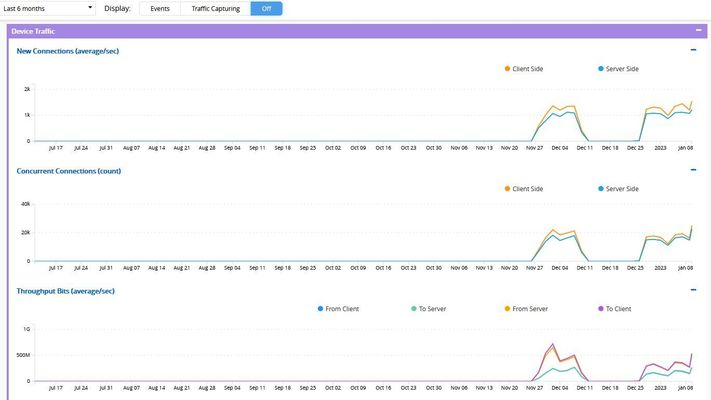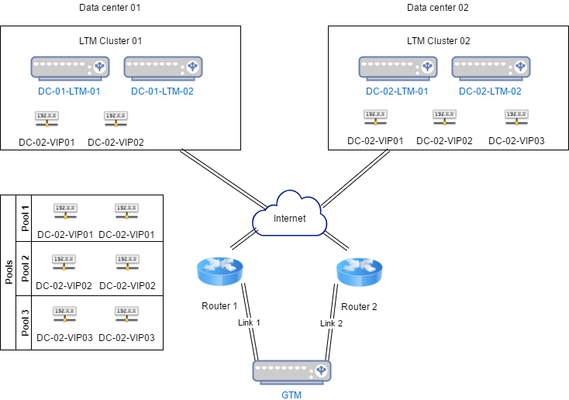statistics
20 TopicsBIG-IQ statistics in dashboard missing/interrupted
Dear all, any idea, why statistics data is missing/interrupted for a few days like in the following screenshot? Or how I can verify any issues? In which logs can I found any hints? The missing data is visible for device statistics as well as for Local Traffic. Am I right, that these statistics are the ones, which are stored on the DCDs? And why is there no data before 27.11.2022? Is there any limit configured that just the last 30 days (or so) will be stored? Does this indicate to an connectivity issue between the DCDs and the BIG-IPs? As of now I could only verify that the ucs backups were successfully executed during these days, so connectivity between the BIG-IQ and the BIG-IPs was fine? Thanks for any useful ideas or hints. Regards Stefan 🙂Solved1.8KViews0likes7CommentsRewrite profile statistics in ltm
Hi, I have some rewrite profiles attatched to LTM virtual servers. I don´t know if they are being used and I would like to delete them if they are not being used. Is there a way to let me know if these profiles are being matched? Thank you very much.855Views0likes3CommentsBIG-IQ v. 5.0- how to view traffic statistics from installed BIG-IP devices
Hello, I have successfully added 4 BIG-IP devices to BIG-IQ from Device Management > BIG-IP DEVICES > Add Device (after installing the required framework using "update_bigip.sh"). Next, I imported the Local Traffic module (LTM) for each BIG-IP from Device Management > Services. Virtual Servers, Pools, etc. for each BIG-IP are being displayed properly in the ADC. My question is- how do I view traffic statistics for virtual servers on each BIG-IP? Specifically, I'm looking for information from the following section of a BIG-IP device: Statistics ›› Module Statistics : Local Traffic ›› Virtual Servers : "virtual_server_name" (this is where the "Traffic Details" in "Bits", "Packets", and "Connections" are displayed). -Thank youSolved814Views0likes8CommentsNew Connections - missing statistics
Hello, I am wondering why there is no data for new connections in the analytics screen Statistics ›› Analytics : Virtual Servers : TCP : Connections I can see avg active and concurrent connections (Traffic Details:Connections) just fine, but I am interested in the connection attempts per second and not the avg active. Is there any logging profile that needs to be activated for that? Running v16773Views0likes2CommentsCount number of connection per server node member
Hi, would like to know if there are any tmsh cut command for the count of each node member hitting on the VIP. I knew the count number of connection per source ip which is below "tmsh show sys connection cs-server-addr VIP | egrep -v 'T|S' | cut -d: -f 1 |sort | uniq -c" i want to know what would i change if i needed to count per server node member. Your help would greatly appreciated!626Views0likes7CommentsGTM to Splunk
Hi Everyone, We have a requirement where in we need to send GTM Logs/Statistics to our Splunk logging server. May we know what parameters can be pulled from the GTM Logs/Statistics that we can send to the Splunk? An example is which WIP uses the most bandwidth or the trend of the ISP Bandwidth usage to determine the time/day the peak is reached. our F5 DNS is running on 13.1.0.4 software version if possible, how can we implement this in our GTM and Splunk? Hope someone can give us an article. Thank you.577Views0likes1CommentGTM - Lingo translated from an LTM perspective (and monitoring)
Dear experts I've set out to find typically good stuff to monitor on the GTM and to do that I had to re-evaluate some terms and things I took for granted from the LTM world. I thought I'd share what I have written down. Hopefully it will help some other poor soul coming from the LTM side to get the grip of the basics. Please do comment if (or actually rather when) I've misunderstood something? A diagram of a basic set-up Lingo Server This is the equivalent of an F5 unit (or a generic server). Data center This is more or less just a container with Servers in them. Data center availability is determined by doing an aggregate checks of virtual server statuses. If all virtual servers are down, the data-center is down, otherwise not. Virtual server These are the classical virtual servers we know from the LTM. Wide IP This is the actual dns record and it's aliases. The wide IP uses a pool containing one or more LTM virtual servers (or, a manually defined fallback server IP). The GTM uses the pool to select the best server based on criteria defined by the admin (GEO-IP based, connections, just plain round-robin, irules etc.). Link A link is a possible path to the internet. In case a GTM is connected to multiple routers it can also use multiple links in case one, or more of the routers is unavailable. If all links are down, the objects monitored via those links also goes down. If no link is specified the GTM would use the configured routing. Listeners This is where the clients would send their DNS queries. You must have at least one in order for GTM to work, but more than one is also possible. Monitoring of virtual servers The GTM would not monitor F5 devices like the LTM monitors its pool members and nodes. Instead it establishes a trust with the devices by running the bigip_add (a bit like device trust) and then the monitoring is done through iQuery. Monitoring In order to get a basic monitoring going I've thought out the following parts. Please let me know if something should be added? Availability: Server availability Data center availability Virtual server availablity Wide IP availability* Link availability Status of iQuery Statistics: Memory, CPU, throughput etc Requests per Wide IP Unhandled requests per Wide IP Total requests per GTM Total unhandled requests per GTM Any comments/feedback very much appreciated!509Views0likes4CommentsNo statistics available (virtuals, cpu)
BIGIP 11.5.1 HF6 Noticed today that statistics for all virtuals are showing "0" even though traffic is actively passing. Data traffic seems unaffected, so far it appears to only be an issue with statistics collection and reporting on the device itself. I do not know how long this has occurred; no changes to the system for some time. It could be something that occurred 'long' ago and was just noticed. Other possibly related information: -Comparison of 'show sys services' indicates that the only daemon not running on active that is running on cluster standby is the racoon daemon. I do not believe this to be directly related to the stats issue since that daemon appears to be related to IKE exchange. Could be another symptom of an underlying cause if memory leak. -'show sys cpu' only displays the first line of utilization. The remaining output that normally shows individual CPU stats only displays a single line "Host:" with no other info/stats. Likely a brute-force fail-over and reboot would solve this, but I'd like to identify the culprit for future reference as well as try to understand why it failed in case there is a larger issue lurking that needs to be addressed. Appreciate your time and feedback.365Views0likes1Comment


